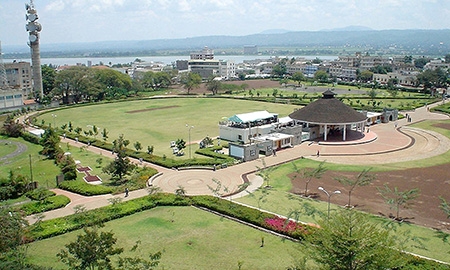A quiet revolution has been taking place here since a new Constitution was approved by referendum in 2010. Suppress the ‘r’ of revolution and replace it by a ‘d’ and you get what’s at play: devolution. Devolution means that powers that were hitherto centralised in Nairobi are devolved to 47 newly created counties, who are now responsible for a wide range of policies, from health to transport and agriculture to trade, to name a few.
According to IRIN news agency, which is run by the United Nations, this is “the most ambitious and rapid transformation of Kenya’s government since independence” in 1963. Why the change? The governmental Task Force on Devolved Government doesn’t mince its words when explaining why: “The post-independence governance framework was characterized by poor governance as evidenced by corruption, ethnic conflict, insecurity, political uncertainty, and poverty,” says the TFDG final report. “Some of the negative outcomes include the alienation of large portions of society from the mainstream economy; wasteful public investments; massive poverty and ethnic animosity; and cut-throat political competition and intolerance.”
According to IRIN, the economic impact of this hyper-centralization was that very few, if any, investments were being made from Nairobi into the provinces, which led millions to migrate to Nairobi in search of work. While the capital was flourishing, remote regions suffered from malnutrition, poor health and inferior services.
Kick-started in 2013 with the election of the first county assemblies, governors and senators, has the reform already borne fruit? It is too early to evaluate its impact on the local and national economy, but it has undoubtedly created high expectations at all levels of society.
Minister of Devolution and Planning, Anne Waiguru says the move will foster deep renovation of the public sector and raise professional standards. While there have been concerns that devolution will simply transfer corruption from the central state to local authorities, Ms. Waiguru is adamant: “We are looking at anti-corruption strategies from all side,” she says. The reform, she adds, is an opportunity to create “a public service that is more productive and defined by its integrity”.
“We have managed to transfer the functions without disruption of services, although there were some challenges in the transfer of payroll. But this was minimal given the magnitude of the transfer: we have 66,000 civil servants, it’s a huge number,” she adds.
The IMF reported that the devolution process “provides the opportunity to foster inclusive growth, increase job creation and address inequality”
----------------------------------------
“Devolution is the best thing that has happened in Kenya”
Jack Ranguma,
Governor of Kisumu County |
According to her, the Kenyan economy could attain 8-8.5% growth “by the end of this term” thanks in part to the “transformed economic infrastructure” that will result from the reform.
Following a visit in July, the International Monetary Fund (IMF) lauded the devolution process. “It is a major undertaking that holds great promises for the Kenyans,” said the IMF. “It provides the opportunity t o foster inclusive growth, increase job creation and address inequality.”
In the 47 newly created counties, local governments have just concluded their first year in office. In Migori, a small territory of just over a million people situated on the western border above Lake Victoria, Governor Zachary Okoth Obado says that “generally, people are satisfied”.
“Devolution is proving to be a means for developing the country by devolving resources closer to the people and giving them direct access to government leadership,” he adds. “We are now able to realize quickly many development initiatives, although we do face challenges, as expected.” (More information on Migori in the interview below).
In Kisumu, another western county of just under one million, situated north of Migori, Governor Jack Ranguma says that, “Devolution is the best thing that has happened in Kenya. We are 51 years old and we’ve had a system based on the English Constitution. Today, we are truly independent.”
He adds that the sectors that have most benefitted so far are health and biotechnology.
Kisumu aims to build growth on its geographical location, near neighboring countries such as Tanzania, Uganda, and further afield Rwanda and Burundi. “Kisumu will grow because it is a commercial hub of the East African economy. Industries that will come here will benefit from the special economic zones and from being on Lake Victoria,” says Mr. Ranguma. “From here, transport to Uganda, Tanzania and Rwanda is cheapest and the cost of production will be half.”
Further north, in
Kakamega, Governor Wycliffe Oparanya, a former Minister of Planning, says that, “Poverty alleviation is our main target”. “With 1.8 million people, we are the second largest county of Kenya, but our poverty level is high at 56%, which means that about one million live below the poverty line,” he explains. “This year, we will receive the largest amount of money this county has received over the past 50 years. It will be transformational.”
The main driver of growth here will be agriculture. “Eighty five percent of our people depend on it to survive,” says Mr. Oparanya. “We are investing 10% of our budget in agriculture. We want to encourage our farmers to diversify from sugarcane into other sectors such as dairy farming, and we are preparing a soft loan scheme to finance them.”
To the west, in the landlocked county of
Nyandarua, with a population of half a million, Governor
Daniel Waithaka Mwangi also sees big opportunities lying ahead. “Devolution is the best thing since independence,” he says. “Once you are given the money as a government, you are the one who makes the decision based on what your people need and require. People are no longer ignored.”
As many other counties in Kenya, Nyandarua relies mainly on agriculture. “My immediate concern is that people work very hard and get little for their labor. For instance we grow 40% of the country’s potatoes but the money people get is negligible. We are now passing an act to ensure that farmers will get the maximum benefit.”

0 COMMENTS